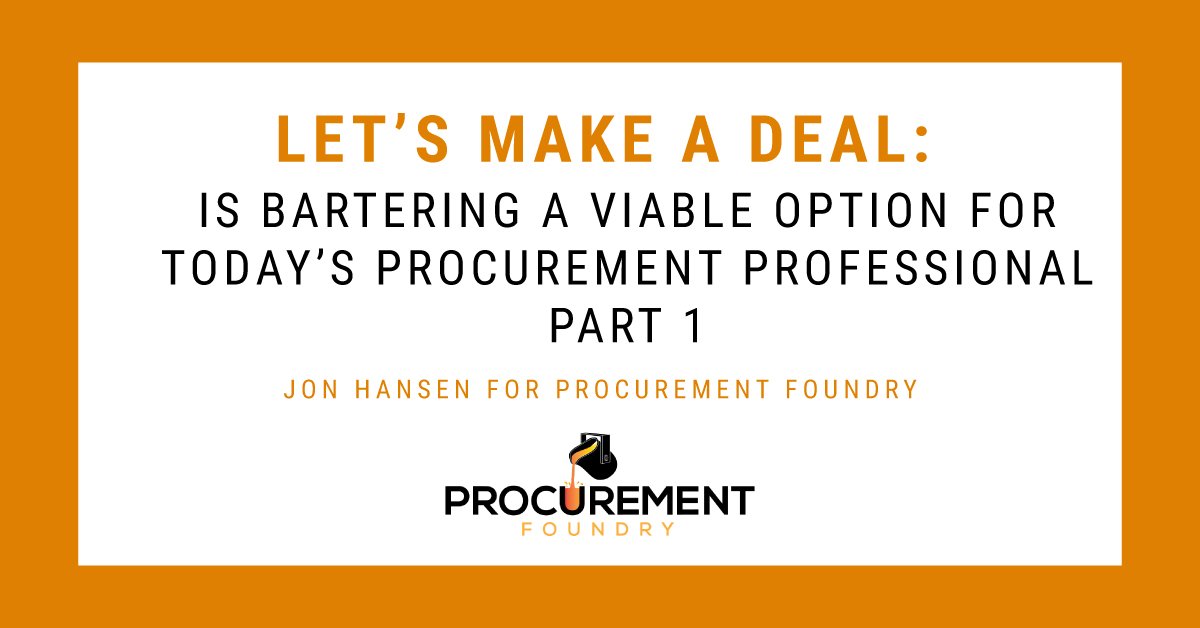Maximizing Savings Opportunities and Procurement's Strategic Value for CPOs
Saving money is not always about pinching pennies: advanced and data-driven insights enable you to identify real cost-saving opportunities, negotiate...
2 min read
![]() Jon Hansen
:
1/30/20 5:44 AM
Jon Hansen
:
1/30/20 5:44 AM

“What’s old, of course, always becomes new again,” begins the recent PYYMNTS.com article about how digital is “stirring a new age of bartering.”
While bartering has been around in many different forms since the beginning of time, it became popular in the 1930s during the Great Depression when money was in short supply.
Acting like financial institutions such as banks, groups of people would convene to facilitate transactions in which members would receive credits instead of currency for items “sold” through the bartering system. These credits could be built up in an individual’s “account” and used by them to acquire goods such as food and clothing.
All-in-all it was an effective system borne out of necessity due to a lack of real currency.
However, and in the absence of a major financial system meltdown, is bartering a viable tool today? Will the emergence of the digital age and corresponding technology stimulate bartering as a viable trade platform for business? Finally, is bartering a feasible model in the procurement world?
A room for work
Conceptually, bartering is a straightforward process. You provide a product or service I need, and in return, I provide you with a product or service you need.
For example, the PYMNTS.com article referred to a story in which a guesthouse in the UK was seeking someone to do renovations on all their bathrooms, as well as a few odd carpentry jobs. In return, they offered access to a “beautiful Victorian property,” providing “quality bed & breakfast accommodation.” The parties were exchanging a room for work” currency.
It is not difficult to envision the scalability of this model in any number of areas, especially given the effectiveness of technology to streamline the process of finding and facilitating trade between interested parties. One might even envision a day when the post-barter fulfillment process is managed on-line in the same fashion as a digital contract or project management application for traditional business agreements.
Suffice to say that the possibilities of an electronic bartering app or platform for business are not entirely out of the realm of possibility in the “near future.”
But, is technology alone enough to make it a viable model in the procurement world?
Moving beyond conceptual
As is the case with any idea that diverges from the familiar, moving from concept to reality is not often a straight-line.
So, to get an idea as to what potential obstacles might exist, we went out to a vast network in social media to find out what they think of bartering as a procurement tool.
Of the responses that have come in so far, one that stood out was a question regarding the viability of the model in public versus the private sector world.
Even though there is some promise “depending on what both parties want to achieve,” the bigger issue is not going to be one of a “consensus on value” of a bartered transaction. The primary deterrent is the belief that at least in the public sector, “it would be a legal minefield,” and as a result, “wouldn’t be workable in public procurement.”
Even putting aside the potential “legal potholes” in the public sector, the road to bartering, in general, might be a tough sell because of questions regarding the ability to “guarantee equal treatment” or ensure transparency throughout the entire acquisition process.
One final observation was the role of contracts with a bartering process. Can you allow different payment methods within the same agreement, and if you do, how do you arrive at a consistent measurement of value between hard currency and barter credit?
Is bartering worth it?
Change is never easy under any circumstance. Having to navigate the complexities of introducing a bartering process in the procurement world creates more questions than it does answers. As a result, and until such time that we can address the issues such as the ones referenced above, bartering will remain an interesting topic for discussion as opposed to a viable “working” model.

Saving money is not always about pinching pennies: advanced and data-driven insights enable you to identify real cost-saving opportunities, negotiate...

The topic of our recent roundtable discussion with a dozen Procurement Foundry community members—exploring potential flaws in procurement incentive...

Every 30 days or so, I get the same alert on my phone—“Your electricity bill is available for viewing.” I take a quick look, make sure nothing seems...